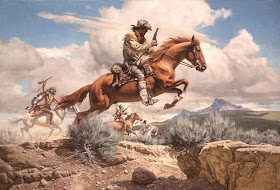




The Pony Express was a mail service where riders on horseback traveled from St. Joseph, Missouri, to Sacramento, California. Riders changed horses at stations placed about ten to fifteen miles apart. A rider handed the mail pack over to another rider after completing about 75 miles. Young, often teenage lightweight riders, orphans preferred, were hired for the job. One of the most famous was Buffalo Bill Cody. The Pony Express was developed by William H. Russell, William B. Waddell, and Alexander Majors. Plans for the Pony Express were spurred by the impending cloud of the Civil War and the need for faster communication with California and the West. The Pony Express consisted of relays of men riding fast ponies or horses that carried letters and small packages across a 1,966-mile trail. The service opened officially on April 3, 1860, when riders left simultaneously from St. Joseph, Missouri, and Sacramento, California. The first westbound trip was made in 9 days and 23 hours and the eastbound journey in 11 days and 12 hours. The pony riders covered 250 miles in a 24-hour day as compared with 100 to 125 miles by the stage coaches. Prior to the start of the Pony Express, there were three mail routes to California. The first was a steamship voyage from New York, crossing the Isthmus of Panama by canoe and mule and next connecting with another steamship run to San Francisco. This journey took 22 days but was used to carry the bulk of western mail prior to the Pony Express. The other two mail service options used wagon routes and stagecoach lines. The central route was used mainly for local mail. It ran from Independence, Missouri, along the Platte River, through South Pass, Salt Lake City, Carson City, and on to Sacramento with a total travel time of 21 days. The third option, the Butterfield Overland Mail Company route, followed an oxbow-shaped path some 600 miles south of the Central Route, taking up to three weeks to arrive in Southern California. During the critical early days of the Civil War, the Pony Express helped to preserve the Union by providing rapid communication between California and Washington, D.C. Both the North and the South wanted California to join them. For the Union, the state provided needed material resources and a far-western base of operations against the Confederacy. The control of California by the South could have stalemated the Federal Government west of the Rocky Mountains where half a million people then lived. Eventually, the Pony Express had more than 100 stations, 80 riders, and between 400 and 500 horses. The express route was extremely hazardous but only one mail delivery was ever lost. The service lasted only 19 months until October 24, 1861, when the completion of the Pacific Telegraph line ended the need for its existence. Although California relied upon news via the Pony Express during the early days of the Civil War, the horse line was never a financial success, leading its founders to bankruptcy.
No comments:
Post a Comment